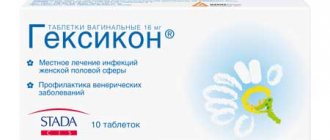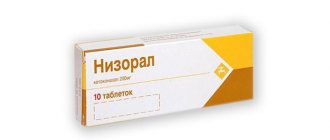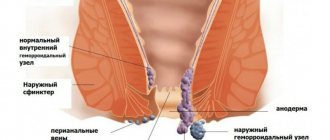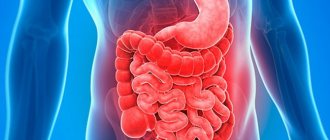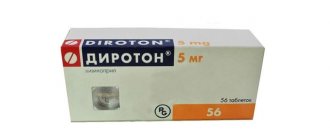Domperidone (tablet form) belongs to the group of drugs for the treatment of functional disorders of the gastrointestinal tract. The instructions for use highlight the following features of the drug:
How to dissolve vascular plaques, normalize blood circulation, blood pressure and forget the way to the pharmacy
- Sold only with a doctor's prescription
- During pregnancy: contraindicated
- When breastfeeding: contraindicated
- In childhood: contraindicated
- For liver dysfunction: with caution
- If renal function is impaired: with caution
Indications for use
Vomiting and nausea caused by:
- carrying out radiation therapy;
- taking certain medications (Morphine, Levodopa, Apomorphine, Bromocriptine);
- organic and functional diseases;
- various infections.
Also indicated for use is
- postoperative intestinal atony;
- hiccups;
- X-ray contrast examination of the gastrointestinal tract;
- flatulence, bloating, heartburn, belching.
special instructions
Against the background of individual intolerance to the components of the drug or when taking incompatible drugs in combination, undesirable effects may occur, to determine the causes of which you must consult a doctor. Symptoms that require stopping the pills include:
- bowel dysfunction;
- dryness of the oral mucosa;
- Strong headache;
- tinnitus (tinnitus);
- dizziness;
- loss of consciousness.
Domperidone, instructions for use (Method and dosage)
The medicine is taken half an hour before meals, without chewing or crushing the tablet.
According to the instructions for use of Domperidone, the maximum daily dose is 80 mg.
In acute cases or with severe nausea and vomiting, prescribe 20 mg, 3 times a day. The last dose is taken immediately before bedtime.
For the treatment of chronic symptoms, take 10 mg, 3 to 4 times a day.
Daily dosage adjustment is required for patients with liver and kidney diseases. In this case, tablets are taken no more than 2 times a day.
Domperidone
D omperidone
(lat.
domperidonum
, English
domperidone
) - a drug for the treatment of functional intestinal disorders, prokinetic, antiemetic.
Chemical compound
: 5-chloro-1-[1-[3-(2,3-dihydro-2-oxo-1H-benzimidazol-1-yl)propyl]-4-piperidinyl]-1,3-dihydro-2H- benzimidazole-2-OH.
Empirical formula: C22H24Cl N5O2. Domperidone is the international nonproprietary name (INN) of the drug.
According to the pharmacological index, it belongs to the group “Gastrointestinal motility stimulants, including emetics.” According to ATC, it belongs to the group “Gastrointestinal motility stimulants” and has code A03FA03. Domperidone blocks dopamine D2 receptors and thus eliminates dopamine inhibition of the motor activity of the digestive system. Increases the duration of gastric antrum and duodenal peristalsis, prevents slow gastric emptying, and increases the tone of the lower esophageal sphincter. The antiemetic effect of domperidone is due to a combination of gastrokinetic action and blockade of chemoreceptors of the trigger zone of the vomiting center. Domperidone prevents the development or reduces the severity of vomiting and nausea.
| The mechanism of the prokinetic action of domperidone (Maev I.V. et al.) |
Domperidone increases the level of prolactin in the blood.
After oral administration, domperidone is rapidly absorbed from the gastrointestinal tract. Food or low acidity of gastric juice slows down and reduces absorption. The maximum concentration of domperidone in the blood is reached after 0.5–1 hour. Found in small quantities in breast milk. It is subjected to intensive metabolism in the intestinal wall and liver (by hydroxylation and N-dealkylation) with the formation of hydroxydomperidone and 2,3-dihydro-2-oxo-1-H-benzimidazole-1-propionic acid, respectively. The half-life after a single dose is 7 hours and increases in chronic renal failure. 31% is excreted by the kidneys, of which 1% is excreted unchanged and 66% is excreted by the intestines (10% unchanged). Domperidone may accumulate in patients with liver disease.
Domperidone belongs to the second generation gastrokinetics and, unlike metoclopramide (trade names Cerucal , Reglan
etc.), does not penetrate the blood-brain barrier (BBB) and does not cause extrapyramidal disorders characteristic of metoclopramide: spasm of the facial muscles, trismus, rhythmic protrusion of the tongue, bulbar type of speech, spasm of the extraocular muscles, spasmodic torticollis, opisthotonus, muscle hypertonicity, etc. .
Also, unlike metoclopramide, domperidone does not cause parkinsonism: hyperkinesis, muscle rigidity. When taking domperidone, side effects of metoclopramide such as drowsiness, fatigue, tiredness, weakness, headaches, increased anxiety, confusion, and tinnitus are less common and less pronounced. Also, while inferior in terms of its effect on gastrointestinal motility to the more effective prokinetic agent cisapride, domperidone does not have its serious side effects (ventricular arrhythmias, cardiac arrest, and even sudden death due to long QT syndrome). Therefore, domperidone is a preferred prokinetic agent over metoclopramide and cisapride
.
In case of overdose
With domperidone, the above extrapyramidal disorders and sedative effects are possible.
In this case, the use of activated carbon, anticholinergics or antihistamines is indicated. Indications for use
.
Nausea and vomiting, including in the presence of infections, with toxemia, radiation therapy, diet disorders, during endoscopic and radiopaque studies of the digestive tract, hiccups, postoperative or other atony of the stomach and intestines.
Feelings of bloating, fullness in the epigastrium, pain in the upper abdominal cavity, belching, flatulence, heartburn, reflux of gastric contents into the oral cavity. At the Department of Children's Diseases No. 2 of the Russian State Medical University, at the Russian Children's Clinical Hospital and the Moscow Research Institute of Pediatrics and Pediatric Surgery, studies were carried out in which it was found that taking domperidone (as opposed to mebeverine) leads to an increase in the rhythmicity coefficient of contractions of the gastrointestinal tract parts studied using electrogastroenterography compared to basal ones. values.
At the same time, there are studies showing that the prescription of dompidone as a prokinetic drug in the complex treatment of GERD in patients with diabetes mellitus is less effective in a number of parameters, such as the intensity of the reduction of esophageal symptoms (heartburn, regurgitation, dysphagia, odynophagia), in the normalization of pH-metry and peripheral electrogastroenterography compared with itopride (Fedorchenko Yu.L.).
Professional medical publications addressing the effects of domperidone on the gastrointestinal tract
- Alekseeva E.V., Fominykh V.P., Tropinskaya N.S., Popova T.S. Use of the prokinetic drug domperidone in patients in the early postoperative period // Surgery. - No. 3. – pp. 62–69. – 2010.
- Ponomareva A.P., Rachkova N.S., Belmer S.V., Khavkin A.I. Peripheral electrogastroenteromyography in pediatric gastroenterology / M.: 2007, 48 p.
- Rebrov V.G., Loginov A.F., Kalinin A.V. Changes in the electrical activity of the stomach and intestines under the influence of motilium / Russian Journal of Gastroenterology, Hepatology, Coloproctology. —1997. - No. 4. - With. 42–45.
- Starostin B.D., Starostina G.A. Clinical and economic effectiveness of motilak in gastroesophageal reflux disease // News of Universities. North Caucasus region. Natural Sciences. Special issue. - 2005. - p. 51–52.
- Arkhipov V.V., Serebrova S.Yu. Safety of the use of prokinetics in the practice of a therapist using the example of domperidone (Motilac) // Russian Medical Journal. - 2007. - Volume 15. - No. 16. - p. 1218.
- Maev I.V., Dicheva D.T., Andreev D.N. Possibilities of using Domperidone in the complex therapy of GERD // Medical Council. 2012. No. 12. pp. 56–60.
- Fedorchenko Yu.L. Comparative characteristics of prokinetics in the treatment of gastroesophageal reflux disease in patients with diabetes // Experimental and clinical gastroenterology. 2013. No. 5. pp. 42–58.
- Lecture by Professor Serhat Bor, Turkey, “Diagnosis and treatment of GERD: what’s new?” (video).
On the website in the literature catalog there is a section “Prokinetics”, containing articles on the use of prokinetics in the treatment of diseases of the gastrointestinal tract.
Contraindications.
Hypersensitivity to domperidone, bleeding in the stomach or intestines, perforation of the stomach or intestines, mechanical intestinal obstruction, hyperprolactinemia, prolactinoma, pregnancy.
For children under 5 years of age and weighing less than 20 kg, taking domperidone tablets is not recommended. Part of domperidone passes into breast milk, so it is not recommended during breastfeeding (the Russian Ministry of Health* proposed to amend the instructions for film-coated tablets, 10 mg, in particular, the list of contraindications for use has been added: moderate and severe liver failure, pregnancy , breastfeeding period, children under 12 years of age or body weight up to 35 kg, simultaneous use of drugs that increase the QT interval and inhibitors of the CYP34A
).
Dosage forms
:
preparations containing domperidone are available in the form of an oral suspension, tablets, lozenges, film-coated tablets.
Side effects.
Digestive system:
spasm of smooth muscles of the gastrointestinal tract, dry mouth, stomatitis, thirst, heartburn, changes in appetite, constipation or diarrhea. Nervous system and sensory organs:
extrapyramidal disorders in overdose, headache, asthenia, irritability, nervousness, drowsiness, leg cramps, lethargy, conjunctivitis.
Allergic reactions:
skin rash, itching, urticaria, swelling.
Urinary system:
change in frequency of urination, burning, difficulty and pain when urinating.
Others:
increased levels of prolactin in the blood plasma, galactorrhea, gynecomastia, menstrual irregularities, mastalgia, palpitations.
( The letter* has added the list of side effects for film-coated tablets, 10 mg: very rarely - urticaria, anaphylactic shock, angioedema shock, convulsions, increased excitability and irritability, drowsiness, headache, changes in liver function tests; frequency unknown - ventricular tachycardia of the “pirouette” type, sudden coronary death.
)
Interaction.
Antacids and antisecretory drugs reduce bioavailability. Anticholinergics weaken the effect of domperidone. Antifungal drugs of the azole group, antibiotics of the macrolide group, and HIV protease inhibitors can block the metabolism of domperidone and increase its plasma level, so their combined use with domperidone requires caution. Concomitant use with monoamine oxidase inhibitors also requires caution. Domperidone does not affect the level of digoxin and paracetamol in the blood.
Trade names of drugs with active ingredients
domperidone: Damelium, Domet, Domperidone, Domperidone Hexal, Domstal, Motilak, Motilium, Motinorm, Motonium, Passazhiks.
Ukraine: Domrid, Domrid SR.
Domperidone is not approved by the FDA for use in the United States. Unlike the USA, in Canada, Japan, China, Israel, Great Britain and most European countries it has such permission.
Medicines with the complex active ingredient domperidone + omeprazole: Omez D and Omez DSR.
All drugs containing domperidone as an active ingredient, including combination drugs, have been transferred from over-the-counter to prescription
.**
Patient materials in English
(for UK, pdf):
- "Patient Information Leaflet for Domperidone Stomach Discomfort Relief Tablets (Domperidone 10 mg)", May 2012.
- "Domperidone 1 mg/ml Oral Suspension. Patient Information Leaflet", 05.11.2012
- "Package Leaflet: Information for the User. Domperidone 10 mg Tablets. Domperidone maleate"
* Letter from the Director of the Department of State Regulation of Medicines of the Ministry of Health of the Russian Federation A.G.
Tsyndymeev No. 20-3/162 dated 03/05/2015 **Letter from the Director of the Department of State Regulation of Medicines of the Ministry of Health of the Russian Federation A.G. Tsyndymeeva No. 20-3/100 dated January 31, 2017. Domperidone has contraindications, side effects and application features; consultation with a specialist is necessary. Back to section
Interaction
Antacids and m-anticholinergics neutralize the effect of the drug on the body.
Also, the therapeutic effect of the drug is reduced by Cimetidine and sodium bicarbonate.
Plasma concentrations and side effects increase when combined with azole-type antifungals, HIV protease inhibitors, the antidepressant Nefazodone, Ketoconazole, macrolide antibiotics (any inhibitors of the CYP3A4 enzyme).
It is acceptable to combine the drug with Paracetamol, antipsychotics, Digoxin, Levodopa, Bromocriptine.
Terms and conditions of storage
The drug Domperidone can be freely purchased at a pharmacy - you do not need a doctor's prescription.
The tablets should be stored according to the instructions in a dark, dry place at temperatures up to 25 ºC. The shelf life of the medicine is 3 years.
Found an error in the text? Select it and press Ctrl Enter.
In a dry place, protected from light, at a temperature not exceeding 25 °C.
Keep out of the reach of children.
3 years.
Do not use after the expiration date stated on the package.
Pharmacological effect
It has an antiemetic effect, soothes hiccups and eliminates nausea in some cases. It has a regulating and normalizing effect on the motor activity of the gastrointestinal tract, which is associated with a blocking effect on dopamine receptors (D2) of the gastrointestinal tract. The action is similar to metoclopramide.
Unlike metoclopramide, it does not penetrate the blood-brain barrier (the barrier between blood and brain tissue) and does not cause extrapyramidal disorders (impaired coordination of movements with a decrease in their volume and tremors).
Contraindications
If liver or kidney dysfunction is diagnosed, the drug is prescribed with caution; the use of tablets by this category of people should be carried out under medical supervision. Pregnancy is a conditional contraindication to taking the drug due to insufficient clinical evidence of the safety of the prokinetic drug for the fetus. During breastfeeding, it is recommended not to use the drug, as the active substance is excreted in breast milk and can cause harm to the baby. Absolute contraindications to taking pills are:
- intestinal obstruction;
- through damage to the intestinal walls;
- bleeding (with a stomach ulcer);
- intolerance to the constituent components.
Use for renal impairment
In patients with severe renal failure (serum creatinine > 6 mg/100 ml, i.e. > 0.6 mmol/l), T1/2 of domperidone increased from 7 hours to 20.8 hours, but plasma concentrations of the drug were lower than in healthy people volunteers.
Because a very small percentage of the drug is excreted unchanged by the kidneys; single dose adjustment is practically not required in patients with renal failure. However, when re-prescribed, the frequency of administration should be reduced to 1-2 times a day, depending on the severity of renal failure. It may also be necessary to reduce the dose.
Release form and composition
The drug is produced in solid form, which is a film-coated, round white tablet convex on both sides. One pack can contain from 10 to 50 tablets. This medication does not have other forms (capsules, suppositories, syrup, injections, etc.).
- One tablet of the drug contains the active component of domperidone - 10 mg + additional substances (microcellulose, colloidal silicon dioxide, macrogol, polyvinyl alcohol, talc, starch, magnesium stearate, polyethylene glycol, titanium dioxide).
Side effects
According to reviews, the drug is well tolerated and rarely causes unwanted effects. The most common side effect of tablets on the digestive system is short-term intestinal spasms. The occurrence of involuntary muscle contractions is not a reason to discontinue the drug - these symptoms are transient and do not affect the functions of the digestive organs. Other possible negative effects include:
- allergic rashes, urticaria, swelling;
- conditions characteristic of elevated levels of prolactin in the blood (amenorrhea, galactorrhea, gynecomastia);
- feeling of thirst;
- change in frequency of urination;
- movement disorders (involuntary muscle contractions).
During pregnancy and lactation
Women during pregnancy are not recommended to prescribe this drug. This is explained by the lack of sufficient data on the effect of the active substance on the fetus.
Women who are breastfeeding are also prohibited from taking Domperidone. The fact is that in breast milk the concentration of the active substance is 10–50% of the amount present in the blood plasma. Infants receiving this drug while breastfeeding have a tendency to develop pathologies of the cardiovascular system.

